Flames lit up the harbor and the cry of battle could be heard. Goblins poured onto the boats from their tall ship, the Maglubiyet’s Bloodaxe. The sailors, however, had an unlikely savior.
Galloping up the dock sped a horse with an unusual rider, a female half-orc barbarian. The horse leaped from the dock onto the deck of the Vigilant, where the fighting was fiercest.
One goblin was felled with a hoof. Another was felled with a javelin.
A dire wolf mounted by a goblin chieftain approached the half-orc.
Welcome to a Mounted Combat 5e Guide.
What is Mounted Combat in 5e?
Mounted Combat is pretty self-explanatory. At least one combatant is mounted on some type steed: horse, camel, elephant, pegasus, griffon, dinosaur, dragon, whatever.
For the following set of rules, there are two criteria:
- The mount must be willing
- The mount must be at least one size larger than the rider
Getting On, Getting Off, and Falling Off Your Mount
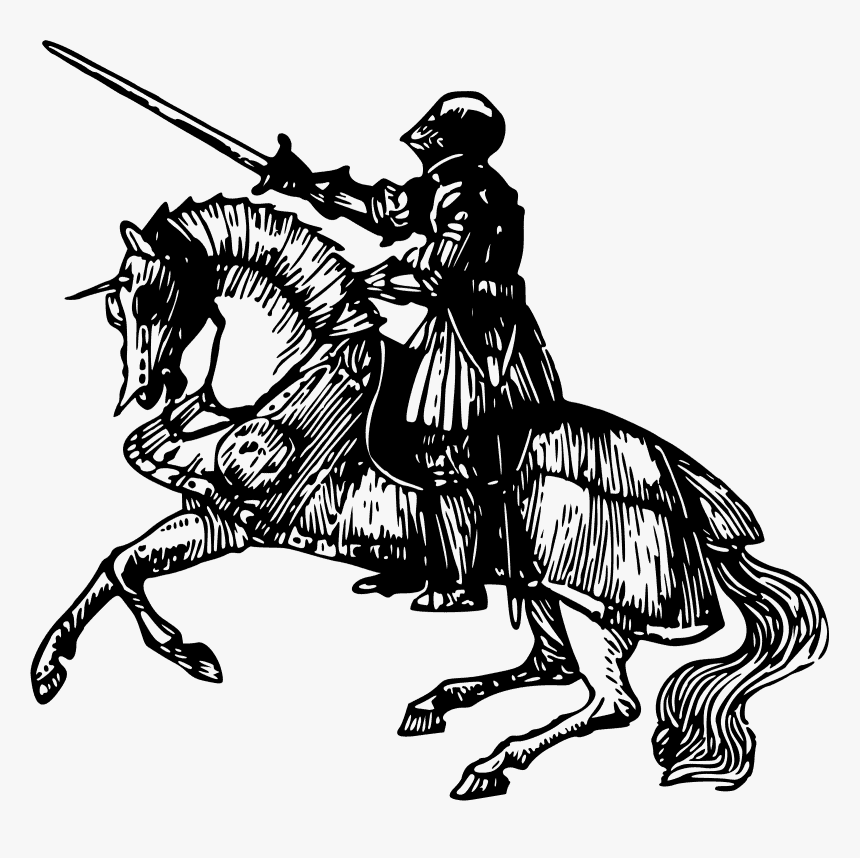
Once per turn, you can mount or dismount a willing creature that is 1 size bigger than you, provided that the creature is within 5 feet. You have to sacrifice half your movement speed for that turn. Example:
Baggi the half-orc barbarian has a movement speed of 30 feet. She cannot mount a horse from 30 feet away in a single turn. It would take her 2 turns.
If she were 20 feet away, she could mount the horse in 1 turn.
movement speed/2 +5 = maximum distance to mount within 1 turn
30 ft /2 = 15 ft
20 -15 = 5 feet
If Baggi is 20 feet away from her horse, she can travel 15 feet and get within 5 feet of the horse. After that, she would still have enough time left within her turn to mount her horse. If she is further than 30 feet away, she would still get within 5 feet of her horse, but not have enough time left to mount the horse.
If a thing or event causes your mount to be moved against its will, you must roll a successful saving throw or fall off your mount. The saving throw is DC 10 on Dexterity. (DC = Difficulty 10) Example:
Baggi is riding her horse into a harbor battle. When she is on the decks of any of these boats, they may or may not move around depending on tides, currents, and other factors. If a boat moves while her horse is on the deck, that horse is being moved against its will. If Baggi is on her horse at that time, her player has to roll a saving throw based on Dexterity DC 10.
Baggi has a Dexterity of 12, so her modifier is +1. Her character must roll a 9 or higher on a 20-sided die. If the player rolls anything less than a 9, Baggi will fall off her horse and land in the prone position, but suffer no damage.
The no-damage part may not sound like the way it would happen in the real world, but the rules for falling damage are clearly stated in the Player’s Handbook (PHB), p. 183. A “creature takes 1d6 bludgeoning damage for every 10 feet it fell”.
The average height for a horse is 5 feet tall at the head and even shorter at the horse’s back where the rider would be seated. If you would like to know more about falling damage, my colleague Emily Medlock at ExploreDND.com has an article about it here: Fall Damage 5e Guide: Falling in Dungeons & Dragons.
Jumping from ship to ship while mounted a “risky maneuver” that calls for an Animal Handling check, and will be talked about later.
What if your mount falls?
Let’s say the DM rules that the movement of the waves and the boat is so violent that Baggi’s horse, Autumn, risks losing its balance and falling. Autumn is a warhorse with a Dexterity of 12 with a +1 modifier. If the DM rates the Difficulty Class as easy like Baggi’s saving throw, the DM would have to roll for Autumn at DC 10. Because Autumn has a +1 modifier, the DM would have to roll 9 or better or Autumn would lose her balance and fall.
If Autumn falls, Baggi could use her reaction to dismount and land on her feet. If Baggi has to sacrifice her reaction to do something else, like a reaction attack, Baggi would wind up prone within 5 feet of Autumn.
Read also: Comprehensive Warhorse 5e Guide.
Controlling Your Mount

You can either control your mount or let the mount control itself.
In the harbor battle above, it is probably better for Baggi to control Autumn. If, however, Baggi was in an environment that the horse knew well, it might be better to let the horse control itself for things like finding food, water, safety, shelter, etc. Were mount the mount a creature of human intelligence or better, like a dragon, the mount might insist on acting independently.
The only mounts that can be controlled would be creatures that have been trained to accept riders. Autumn, as a warhorse, has been trained. A controlled mount has its initiative match that of its rider, so Autumn acts at the same time that Baggi acts.
Controlled mounts normally have three action options: Dash, Disengage, Dodge.
Some mounts, like warhorses, are trained both to be controlled and to fight.
Your mount can move and act on the same turn that you mount it.
Dash
If you direct your mount to Dash, your mount will move at double its movement per turn. Example:
Baggi sees goblin pirates attacking moored ships in the harbor. She wants to help some human sailors that are on the nearest ship, the Vigilant, which is 100 feet away. Autumn is standing 20 feet away from Baggi when she sees the pirates.
In one turn (6 seconds), Baggi and Autumn do the following:
- Baggi closes the 20-foot distance and mounts Autumn
- Baggi directs Autumn to Dash to the ship
- Autumn closes the 100-foot distance to the ship
All perfectly legal. Whether or not Autumn can board the ship in the same turn depends on whether or not a maneuver is required. If the ship has a very wide gangplank attaching it to the dock, a maneuver might not be required.
The current record for horse jumping is about 8 feet high and 28 feet wide. Therefore, half that, 4 feet high and 14 feet wide, should not be too much of a problem for your average warhorse, provided that it wants to do that.
As a DM, I would rule that a distance equal to or less than 2 feet high and/or 7 feet wide is so easy for a trained warhorse that it wouldn’t even count as a maneuver. In such a case, Baggi could have Autumn use the remaining 20 feet of movement on her Dash to clear that distance within the same turn.
Further than that, however, would be a maneuver, in my opinion. When it is a maneuver and how difficult the maneuver is are things not stated in PHB. Example:
Baggi directs Autumn to Dash 100 feet to the ship and jump 10 feet from the dock to the ship. Because Autumn’s movement speed is 60 feet, making a Dash up to 120 feet is not a problem. Getting a running start from a Dash would probably help for a 10-foot jump, so I, as A DM, would rule it to be an easy maneuver, DC 10.
This is not a test of Autumn’s athleticism, but Baggi’s skill at controlling Autumn. Baggi has to make an Animal Handling check. Baggi has the Animal Handling skills proficiency as one of the skills she chose for her barbarian class. She is a 4th level character, so her proficiency modifier is +2. Baggi’s Wisdom is 13, so her ability modifier is +1. Baggi’s total Animal Handling modifier is +3. That means that Baggi’s player has to roll a 7 or higher on a 20-sided die to pass the Animal Handling check.
If Baggi fails the check, the DM could choose many possible outcomes. Autumn could fail the jump and fall in the water. Autumn could make the jump but land badly on the deck and fall. Autumn could simply refuse to jump.
Dodge
Let’s say Baggi and Autumn make a successful jump onto the deck of a ship. Maybe some goblins attack immediately with light crossbows and aim for Autumn. Baggi can direct Autumn to Dodge. This means that the attacking goblins have disadvantage on their attack rolls. If Baggi directs Autumn to Dodge, Autumn can’t do anything else for that turn.
Baggi, however, can still fight the goblins while Autumn is using Dodge. So, if while mounted on Autumn, Baggi wants to throw her javelin at a goblin while Autumn uses Dodge that is fine. If the goblins charge and engage in melee, Baggi can also direct Autumn to Dodge melee attacks as well.
Disengage
Disengage allows the combatant to withdraw from combat without turning his or her back and granting the opponent an opportunity attack.
If the goblins start to overwhelm Baggi and Autumn, Baggi can direct Autumn to Disengage. If she simply has Autumn run away, the goblins would have opportunity attacks on both Autumn and Baggi.
Like all horses, warhorses can fight. Whether or not they can be directed to fight, however, hasn’t been stated in the rules. In the real world, they can be directed to fight. I’ve seen a policeman direct his horse to fight with my own eyes.
If a warhorse like Autumn makes an attack with her hooves, she would have a +6 to hit and do 2d6 +4 bludgeoning damage.
If a warhorse moves at least 20 feet towards a creature before attacking with hooves, a successful hit can force the victim to roll a saving throw, DC 14 Strength, or be knocked down to a prone position. If an opponent is knocked prone, the warhorse can attack again with hooves as a bonus action in what is called a Trampling Attack.
Independent Mount
Autumn, like all warhorses, is a mount that can be controlled. Dragons, for example, are usually intelligent and choose to act independently, even if they accept riders.
Independent mounts have their own initiative rolls. Therefore, if Baggi was riding a dragon, the dragon might roll higher in the initiative order and not wait for Baggi to decide what to do. If Baggi rolls higher, she would have to decide her action before the dragon’s turn.
Not all independent mounts are very intelligent either. Let’s say the goblins have a couple of chevaliers of their own, goblin chieftains mounted on dire wolves. Wolves and dire wolves are wild animals and not that easy to domesticate. At any point in the battle, they might disobey their riders. They might jump on wounded sailors for a snack or run away and provide Baggi and the sailors with opportunity attacks.
Animal Handling
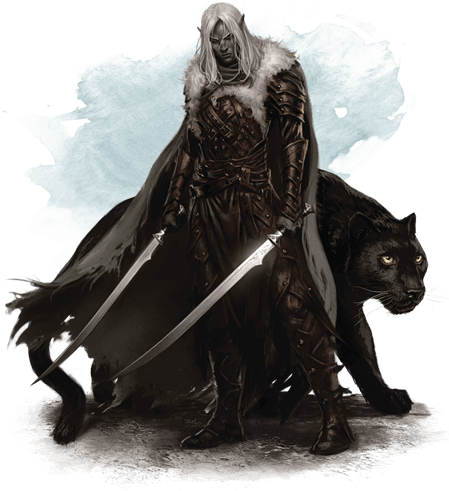
As stated earlier, an Animal Handling check is necessary if a rider directs a mount to perform a maneuver. It is also necessary to calm a mount down if it gets spooked. It can also be used to check to see if the rider detects the mount’s intentions. Example:
Horses tend to be afraid of wolves. Warhorses are bred to be less afraid but a couple of giant wolves, dire wolves, might affect even a trained horse. Maybe Autumn is thinking about running away. A successful Animal Handling check could give Baggi some early warning.
Likewise, maybe these goblin chieftains don’t want their dire wolves to start eating sailors until after the battle is over. If these chieftains are wise, they might pass an Animal Handling check and be able to fix the situation before it gets out of hand.
Mounted Combatant
This is a feat that a character 4th level or higher can purchase instead of getting ability score improvements (ASIs) of 2 points. It has three benefits:
- The rider has an advantage on melee attack rolls against unmounted creatures that are smaller than the rider’s mount.
- The rider can shield his or her mount by forcing opponents to attack the rider instead.
- If your mount is forced to make a Dexterity saving throw, it only takes half damage if it fails, and no damage if it succeeds.
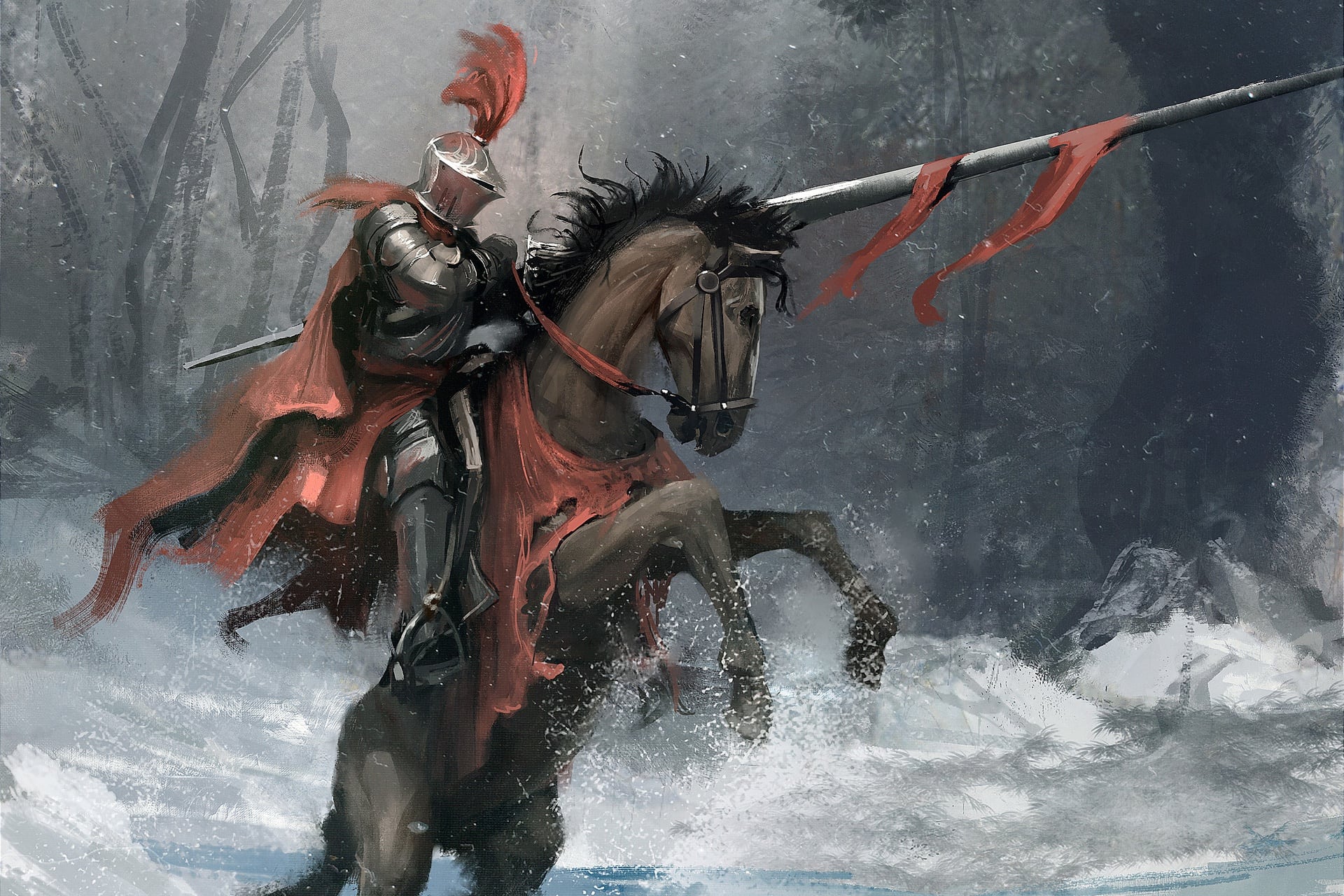
As a player, I don’t want to trade my ASIs (ability score improvements) for feats. I certainly wouldn’t have a barbarian like Baggi purchase the Mounted Combatant feat. Regardless, for the purpose of having some examples, let’s pretend I do just that and have Baggi purchase Mounted Combatant as a feat as soon as she reaches 4th level.
Example 1: Baggi is at the harbor battle with Autumn. Rather than throwing her javelin, Baggi stabs at a goblin with her javelin.
The goblin has AC 15. Baggi has +5 on her attack roll, so her player needs to roll a 10 or better on a 20-sided die to hit. I roll an 8 miss. However, since I’ve purchased the Mounted Combatant feat, I have an advantage on my attack. That means I get to roll twice for each attack and pick the better of the two. My next roll is 12, a hit.
Baggi has +3 to damage rolls due to her Strength. Her weapon is a flail which does 1d8, on average 4 points of damage. The goblin only has 7 hit points. 4 + 3 = 7 or 1 dead goblin.
Example 2: 3 goblins try to attack Baggi. Autumn isn’t wearing any barding, so Baggi is worried about her. Baggi uses her Mounted Combatant feat to force the goblins to attack her instead of Autumn.
As a warhorse, Autumn has AC 11. As an unarmored barbarian with a shield, Baggi can add both her Dexterity and Constitution modifiers, +1 and +3 respectively, to her AC for a total of AC 16.
Example 3: The goblins have an alliance with an evil wizard. From the Maglubiyet’s Bloodaxe, he spies Baggi and the Vigilant. He aims a fireball right at the deck.
Everyone on deck, sailors, goblins, dire wolves, has to roll a saving throw, including Baggi and Autumn. For most of the sailors and goblins, there is no point, because they don’t have enough hit points to survive a saving throw even if they do make the save. They get incinerated and scream in agony before they die.
With Baggi and Autumn it’s different. Baggi, as a 4th-level barbarian with 16 Constitution, has 42 hit points. Autumn, as a warhorse, has 19 hit points.
The fireball is a 24-damage-point fireball. Even Baggi fails the save, she’ll have almost half her hit points left. Autumn, however, cannot survive a failed save. Even with a successful save, Autumn would lose 12 out of her 19 hit points and be in pretty bad shape.
With the Mounted Combatant feat, however, Baggi can save Autumn’s life, even if the save is failed. Autumn has a Dexterity of 12, so she gets a +1 modifier to her save. The evil wizard has an Intelligence of 18 with a modifier of +4. That means that the DC for the spell is 8 +4, 12. (PHB, p. 205)
Autumn has a Dexterity of 12, so she gets a +1 to her roll. The roll is a 13, a total of 14, so Autumn makes the save. Normally, Autumn would still suffer 12 points of damage from her 19 hit points and only have 7 hit points left. However, since Baggi has the Mounted Combatant feat, Autumn suffers no damage and simply dives into the water of the harbor before the fireball’s explosion reaches her.
Unwilling Mounts
A mount must be willing. If you try to force a creature to carry you or do anything else while carrying you, you are not directing that creature. You are grappling with that creature and you follow the grappling set of rules to determine what you can and can’t do.
Mount Gear
In the real world, bits and bridles, stirrups, and riding crops are all important. In gaming terms, however, only saddles are relevant.
Saddles
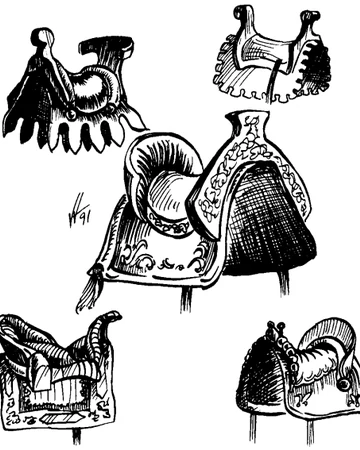
A saddle on the mount allows the rider to roll at advantage when they have to roll a Dexterity save to stay on the mount.
When Baggi was riding Autumn on deck and the ship was being tossed about by waves, Baggi had to roll a Dexterity saving throw to not fall off Autumn. Had Autumn been wearing a saddle, Baggi would have been able to roll at advantage.
Lance
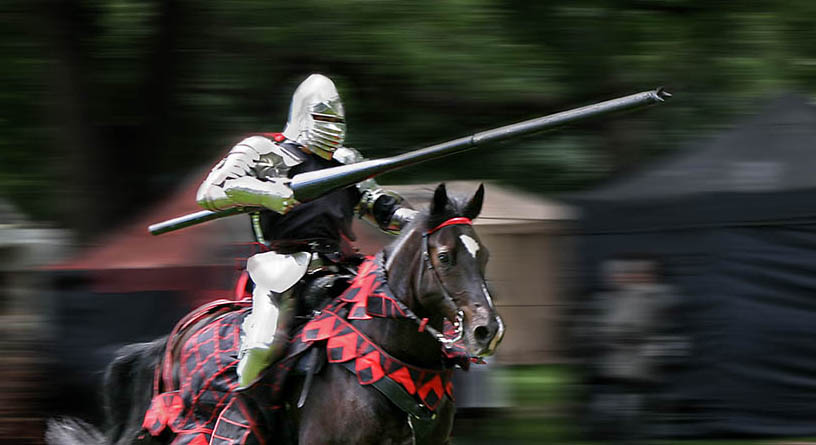
A lance is a weapon specifically designed for mounted combat. When used while mounted, the rider can operate a lance one-handed and employ a shield as well. A lance does 1d12 piercing damage, which is more than you would normally get with a one-handed weapon.
It also has the reach property, so the rider can attack opponents from 5 feet away. However, if an opponent gets within 5 feet of the rider, the lance operates at a disadvantage.
Once the rider has dismounted, however, the lance becomes a clumsy weapon and requires 2 hands for its use and still has a disadvantage if an opponent gets within 5 feet.
Example: After swimming to shore from the burning ship, Baggi and Autumn return to the docks. Baggi finds a discarded lance and heads into the town in case the goblins start attacking women and children.
On her way into town, she is challenged by another rider, a goblin chieftain mounted on a dire wolf. The rider is wearing chain mail and is armed with a scimitar and shield.
Baggi decides not to charge into her opponent, but to “make a pass” by charging alongside the opponent at 5-foot distance. Her intention is to kill the goblin rider without exposing herself to the goblin’s scimitar or Autumn to the dire wolf’s teeth.
The lance has the reach property and the scimitar does not, so there is no need to roll for initiative. The goblin chieftain, with chain mail, shield, and 14 Dexterity has AC 20. Baggi has a +5-attack bonus so she needs a 15 to hit. A 16 is rolled, so the goblin chieftain is hit.
A 1d12 is rolled for an 8 with a +3-damage modifier for Baggi’s Strength. The goblin chieftain has 14 hit points and is now down to 3.
The goblin wants to attack with his scimitar, but Baggi and Autumn have already ridden past him. He could try to catch up to them on his dire wolf. However, the dire wolf has a movement speed of 50 feet per turn, while Autumn’s movement speed is 60 feet per turn. That means that Autumn can easily outrun the dire wolf and only needs to engage the dire wolf when she wants to.
Baggi prepares Autumn to make another pass at the goblin. The goblin chieftain has a decision to make. He can fight with his scimitar, but he does not have the reach to touch her. He can retreat on his dire wolf, but the warhorse can outrun them. He sheaths his scimitar and draws his shortbow.
Now he has the range to attack Baggi and Autumn. If Baggi closes to within 5 feet of the goblin, he will be at a disadvantage because he is making a ranged attack at close quarters. Baggi also will be at a disadvantage, because she is using a lance at close quarters, within 5 feet. Of course, for the next pass, the goblin chieftain’s AC is no longer 20, but 18 because he has had to put away his shield to have both hands free to use his bow.
If the goblin chieftain is killed, the dire wolf will be in a very bad situation. The dire wolf can’t use its rider’s shortbow. The wolf doesn’t have the reach to match Baggi’s lance and it doesn’t have the speed to get past Baggi’s lance as long as she is mounted on Autumn. At AC 14 and 37 Hit Points, this dire wolf would normally be a very tough opponent, even for Baggi and Autumn.
With the lance’s reach combined with Autumn’s speed, however, the dire wolf is ultimately doomed should it lose its rider. Even if wants to run away, Autumn will catch up. Considering that Baggi knows that the dire wolf and its rider were on its way into town to massacre women and children, Baggi will not be in a merciful mood.
Magic Items
In the Dungeon Master’s Guide (DMG), there is one magic item specifically geared towards mounted combat, the Saddle of the Cavalier, DMG p. 199.
The saddle is magically secure, so the rider cannot be dismounted unless the rider wills it. Attack rolls against the mount are at a disadvantage.
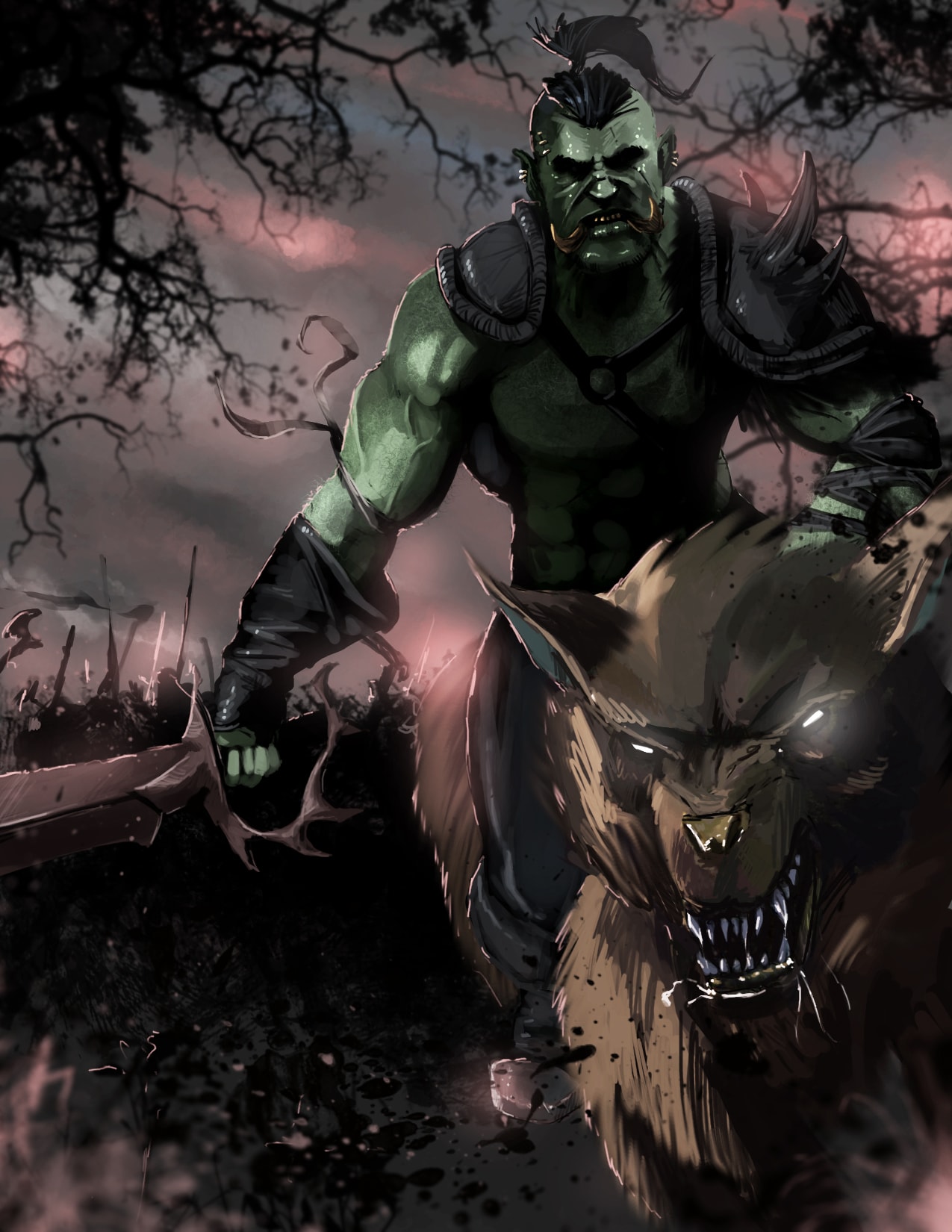
Example: Baggi has killed the goblin chieftain and is slowly picking the dire wolf apart with her lance. After the dire wolf has lost half its hit points, it grabs the lance and breaks it. Baggi could have Autumn run away and the wolf would have no chance of catching up, but she doesn’t want the dire wolf making into town where the women and children are. Drawing her flail, Baggi engages the dire wolf.
If Baggi has the Mounted Combatant feat, she doesn’t need the Saddle of the Cavalier to protect Autumn. She can simply force the dire wolf to directs its attacks at her, Baggi, rather than Autumn. That wouldn’t work against an ambush, however.
Example: A female goblin sniper has heard the battle and has used her stealth to approach the combatants through the tree line. From a distance of 80 feet, she draws her shortbow and decides to aim for the horse. Luckily for Autumn, Baggi had acquired a Saddle of the Chevaliers on her previous adventure.
The goblin sniper has a +4-attack modifier. Autumn’s AC is 11, so the goblin needs a 7 or higher to hit her. The DM rolls a 10, a hit! But wait, the goblin sniper’s attack is at a disadvantage, due to the Saddle of the Cavalier.
The DM has to roll twice and accept the lower roll. The second roll is a 5, a miss. The DM has to take the 5 and the miss because that’s how disadvantages work. Autumn decides that she likes this rule and this saddle and Baggi decides that it might be time for a barbarian rage.
Mount Animal Stats
Here are some of the most common mounts that appear in PHB. I included dire wolves because of the battles above. Obviously, there are many fantastic creatures that could be included that are beyond the scope of this article: dragons, unicorns, pegasi, griffon, hippogriffs, riding lizards, etc. Even in the real world, there are camels, elephants, ponies, and mules that could also be included.
Warhorse

AC 11
Hit Points 19 (3d10+3)
Speed 60 ft.
| STR | DEX | CON | INT | WIS | CHA |
| 18 (+4) | 12 (+1) | 13 (+1) | 2 (-4) | 12 (+1) | 7 (-2) |
Hooves: +6 to hit, Damage 2d6 +4 bludgeoning
Trample attack (see above)
| Barding | Leather | Studded leather | Ring mail | Scale mail | Chain mail | Splint | Plate |
| AC | 12 | 13 | 14 | 15 | 16 | 17 | 18 |
Riding Horse
AC 10
Hit Points 13 (2d10 +2)
Speed 60 ft.
| STR | DEX | CON | INT | WIS | CHA |
| 16 (+3) | 10 (+0) | 12 (+1) | 2 (-4) | 11 (+0) | 7 (-2) |
Hooves: +5 to hit, Damage 2d4 +3 bludgeoning
Dire Wolf
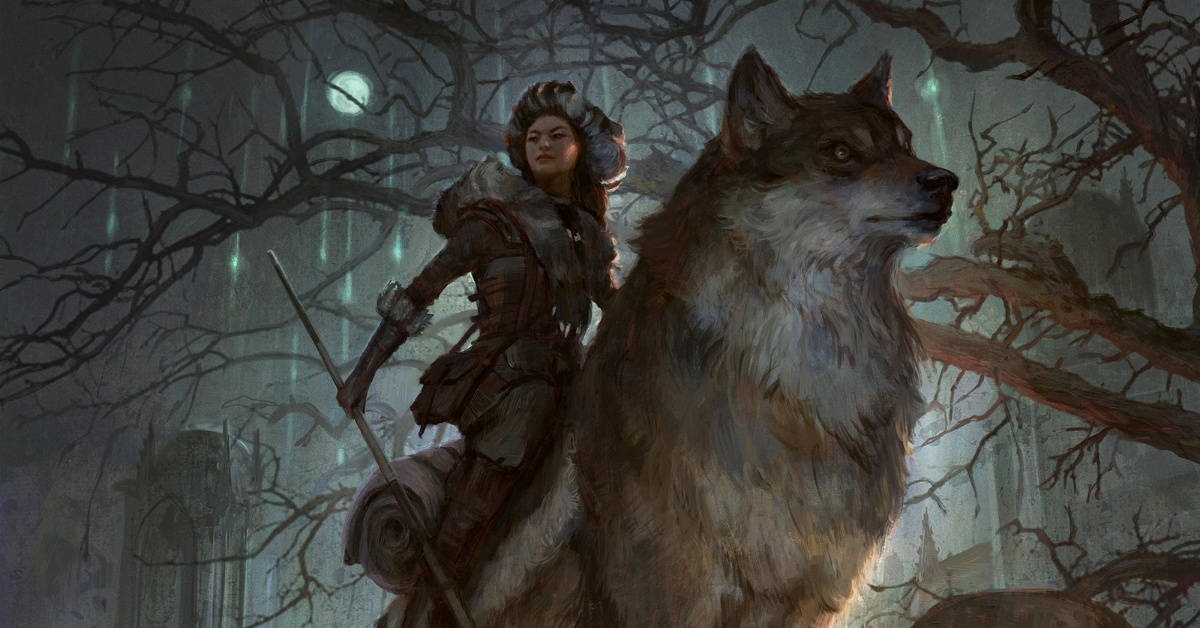
AC 14
Hit Points 37
Speed 50 ft.
| STR | DEX | CON | INT | WIS | CHA |
| 17 (+3) | 15 (+2) | 15 (+2) | 3 (-4) | 12 (+1) | 7 (-2) |
Skills: Perception +3, Stealth +4
Special Abilities: Keen Hearing and Smell, Pack Tactics, Knocking Prone Attack
Bite +5 to hit, Damage 2d6 +3 piercing damage
FAQs
Question: If I have Mounted Combatant feat, am I protected on Dexterity saves in the same way that my mount is?
Answer: If I’m the DM, yes. If the horse you’re riding successfully dodges a fireball or catapult, you do too. It should be this way especially when you consider how expensive a feat is.
Question: Does Mounted Combatant feat help my Animal Handling proficiency?
Answer: No, it doesn’t help unless the DM is feeling generous.
Question: Who has access to Animal Handling proficiency?
Answer: For classes within PHB, barbarians, bards, druids, fighters, and rangers. For backgrounds in PHB, Folk Hero only. You can also buy Skilled as a feat on reaching 4th level or higher and choose Animal Handling as one of 3 new proficiencies.
Question: Can a barbarian rage while mounted?
Answer: RAW (rules as written), there’s nothing that says that they can’t. If you think about it, there were plenty of horse-born nomads like the Mongols and Huns. One could argue that they had their share of barbarians. Attacking opponents with the ferocity of a berserker could happen with nomadic people like especially if they were nearly as comfortable on horseback as they were on their feet. I would say, however, that using certain tactics, like making a pass with a lance in the way that Baggi did against the goblin chieftain, wouldn’t work with raging. You can’t attack, withdraw out or reach, and attack again, and call it a rage.
Question: Could a lance be used to knock a rider off horseback?
Answer: In the real world, yes. RAW, no. At least not in PHB. Of course, if the DM wants to homebrew a lance option like that, it would make sense.
Question: Can I direct my mount to attack while I attack separately?
Answer: If I’m the DM, yes, provided that the mount is trained for combat, like the way a warhorse would be. RAW, you can only direct your mount to Dash, Dodge, or Disengage. If I’m the DM, Autumn can attack with hooves and possibly trampling, while Baggi attacks with the weapon of her choice. Such an action could even be combined with a Dash.
Conclusion
Mounted Combat adds a new dimension to combat in 5e Dungeons & Dragons. The movement is different and the tactics are different.
When I play-tested Baggi and Autumn, I gained a new respect for the Mounted Combatant feat. While I normally wouldn’t want to part with ASIs for my character, the Mounted Combatant feat is really important for players that are especially concerned with keeping their mounts alive. My experience has been that this becomes an issue after characters graduate from the lower levels.
Baggi, as a tough barbarian, has more than double the hit points of her mount, and 4th level is still not high level. For the purposes of killing monsters and taking treasure, Autumn is replaceable because Baggi could always buy another warhorse with more treasure. But for the purposes of good role-play, who wants to see their mount get killed? Autumn isn’t just Baggi’s warhorse; she’s her companion.
If you’d like to see Baggi’s stats and more information about her origins and personality, she was introduced to ExploredDND.com through my article Half-Orcs 5e Guide: Misunderstood but Self-Reliant.
- Perform Bewitching 5e Guide - October 1, 2022
- Inspiring Leader 5e Guide - September 20, 2022
- Scrying 5e Guide - September 19, 2022

